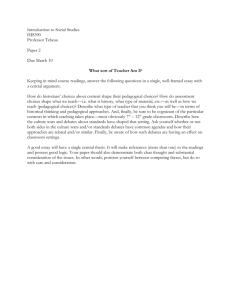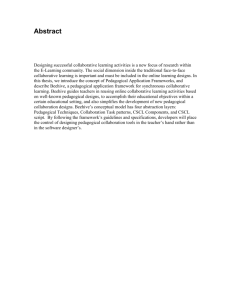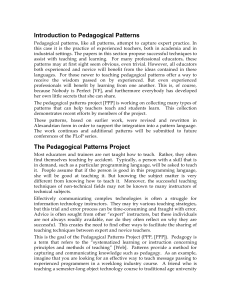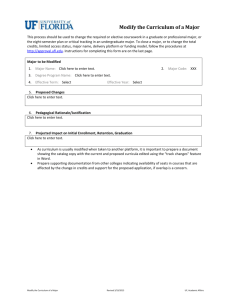Impact on Student Learning Paper
advertisement
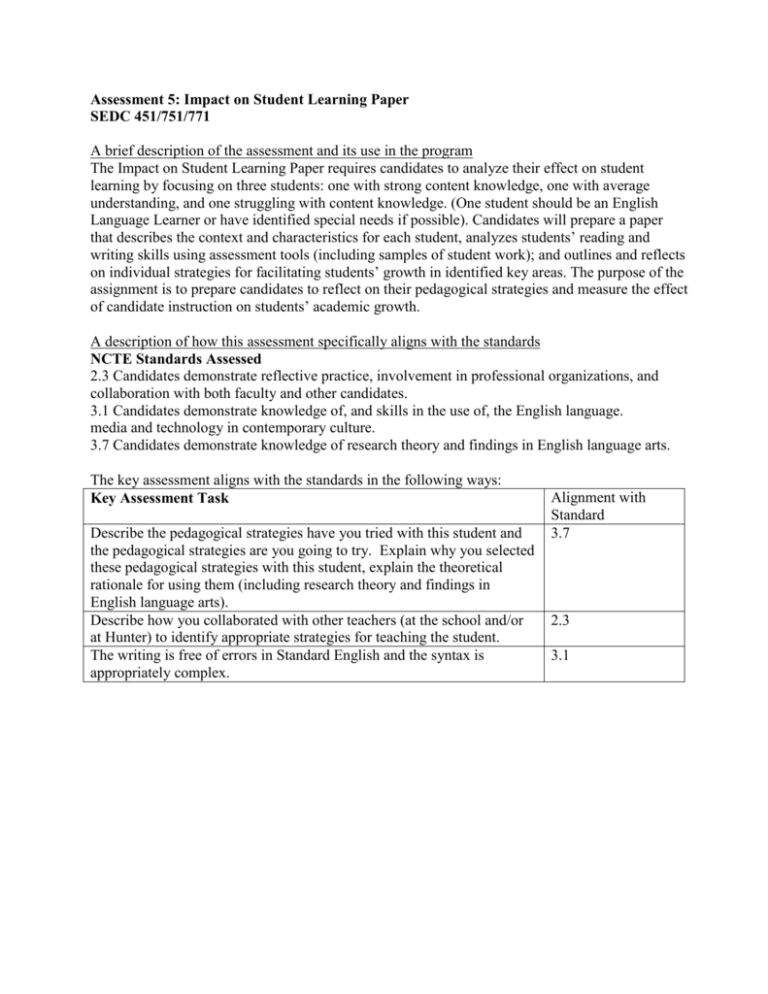
Assessment 5: Impact on Student Learning Paper SEDC 451/751/771 A brief description of the assessment and its use in the program The Impact on Student Learning Paper requires candidates to analyze their effect on student learning by focusing on three students: one with strong content knowledge, one with average understanding, and one struggling with content knowledge. (One student should be an English Language Learner or have identified special needs if possible). Candidates will prepare a paper that describes the context and characteristics for each student, analyzes students’ reading and writing skills using assessment tools (including samples of student work); and outlines and reflects on individual strategies for facilitating students’ growth in identified key areas. The purpose of the assignment is to prepare candidates to reflect on their pedagogical strategies and measure the effect of candidate instruction on students’ academic growth. A description of how this assessment specifically aligns with the standards NCTE Standards Assessed 2.3 Candidates demonstrate reflective practice, involvement in professional organizations, and collaboration with both faculty and other candidates. 3.1 Candidates demonstrate knowledge of, and skills in the use of, the English language. media and technology in contemporary culture. 3.7 Candidates demonstrate knowledge of research theory and findings in English language arts. The key assessment aligns with the standards in the following ways: Key Assessment Task Describe the pedagogical strategies have you tried with this student and the pedagogical strategies are you going to try. Explain why you selected these pedagogical strategies with this student, explain the theoretical rationale for using them (including research theory and findings in English language arts). Describe how you collaborated with other teachers (at the school and/or at Hunter) to identify appropriate strategies for teaching the student. The writing is free of errors in Standard English and the syntax is appropriately complex. Alignment with Standard 3.7 2.3 3.1 Description of the Assignment You will write a paper that addresses your impact on student learning. After reviewing the work of the entire class, select three students as subjects for three “case studies.” (One with strong content knowledge, one with average understanding, and one struggling with content knowledge/skills.) If possible, one student must be an English Language Learner or have identified special needs. Each case study should include the following elements, as well as evidence of a pre- and post-assessment that demonstrates the impact of instruction on learning. Characteristics of Each Student (Including information from home contact if possible) Who is this student? Describe the student’s history (learning/personal), needs and interests Why did you select this student? What are your goals with this student? Description of Pre-Assessments (One reading and one writing assessment for each student): Explain how you administered the assessments and why you chose each assessment. Include specific detail about what information you learned and refer to specific evidence from the assessment (e.g. students’ writing, comments shared during a reading conference) to support your analysis. Potential assessment tools may include: 6 traits of writing rubric Assignment rubrics Student writing samples Notes from individual conferences Fluency rubric Reading Conference Reading interview Writing interview Any other reading/writing assessments that are used at your school Pedagogical Strategies with Each Student: Based on information from your pre-assessments, describe the pedagogical strategies you implemented to support each student based on his/her needs. What pedagogical strategies did you implement with this student? Why these pedagogical strategies with this student? What is the theoretical rationale for using them? (Standard 3.7) You must cite program readings and research. How have you collaborated with other teachers (at the school and/or at Hunter) to identify appropriate strategies for teaching this student? Description of Impact on Student Learning from Post-Assessments and Reflection (Standard 2.3) What evidence do you have that your strategy impacted student learning? What do your post-assessments (for reading and writing) of each student’s work reveal about his/her learning? What are your “next steps” with each student? Conclusion What have you learned about teaching the full range of secondary students from this exercise? Additional items to consider for your paper: You must attach all assessment tools and/or samples of students’ work before and after (pre- and post) as Appendices and label these in the body of your paper. Employ a strength over deficit model: You must demonstrate a strength over deficit approach to using language to construct your case study participants. Examples of such language do not include/include: Deficit perspective “Anna lacks the ability to…” “Anna is a poor reader who cannot…” “Anna is disrespectful…” “ Strength over deficit perspective “Anna struggles with…” “Anna is a motivated reader but finds it difficult to…” “Anna has a tendency to show frustration in in class when reading more difficult texts…” Use a pseudonym for the names of students and schools Include a bibliography of all sources using APA The scoring guide for the assessment Below Standard Description of Description is sketchy and does Each Student not provide a full description of the student, his/her history, the 15% of grade rationale for selecting the student for assignment and the teacher’s goals for the student. Pedagogical Strategies with Each Student 30% of grade for assignment Standard 3.7 Assessments of each Student’s Work (Before and After) 20% of grade for assignment Pedagogical strategies do not appear well related to the student’s needs or the teacher’s goals for the student. The rationale for using them is not fully provided, there is little description of past strategies, and there is little or no reference to theory underlying the strategies, including research theory and findings in English language arts. There is scant description of the materials or other resources used to support instruction. The writing includes multiple errors and lacks fluency and/or complex syntax. Student work (either before or after sample or both) is missing or incomplete. Samples do not appear to relate to the pedagogical strategies described. The samples do not represent before and after work of an individual student and/or are poorly described. At Standard There is an adequate description of the student including his/her history, the rationale for selecting the student the teacher’s goals for the student. The description is appropriately detailed, and the teacher’s goals relate to the description of the student. Pedagogical strategies are appropriately related to the student’s needs and the teacher’s goals for the student. The rationale for using them is fully provided and makes appropriate reference to theoretical underpinnings of the pedagogy selected including research theory and findings in English language arts. Collaborations with other teachers are well described and relevant to identifying appropriate strategies. Materials and resources used as part of instruction are well described and relate to the strategies and goals. (Std 3.7) Above Standard The description of the student provides rich level of salient detail that is well documented. The rationale for selecting the student and the teacher’s goals for the student are extremely well described. The teacher’s goals are very well tailored to the student’s needs as described. Student work, both before and after, is included and clearly relates to the pedagogical strategies described. Descriptions and rationales for each assessment are clear and relevant. Student work, both before and after, is included and strongly relates to the pedagogical strategies described. Descriptions and rationales for each assessment are clear, relevant, and comprehensive. Pedagogical strategies are extremely well related to the student’s needs and the teacher’s goals for the student and demonstrate great skill in selecting pedagogical strategies to meet this student’s needs. There is detailed description of past strategies and their impact. The rational for the strategies selected is extremely well thought out and makes insightful and salient reference to the theoretical underpinnings of the instructional approaches selected including thoughtful use of research theory and findings in English language arts. Collaborations with other teachers are extremely well described and highly relevant to identifying appropriate strategies. Materials and resources are very well described and are well tailored to the strategies and goals. (Std 2.3, 3.7) Reflection and Conclusion 30% of grade for assignment Standard 2.3 Use of standard written English Standard 3.1 5% of grade for assignment Below Standard The reflection does not discuss all the required material; detail is sketchy and there is little evidence of insight about the student’s learning. There is little or no description of next steps with the student or of implications for teaching secondary English. The student does not adequately demonstrate reflective practice in describing and analyzing work with the student. The writing includes multiple errors and lacks fluency and/or complex syntax At Standard The reflection discusses all the required material; there is adequate detail. The reflection provides evidence of insight about the student’s learning, about next steps, and about the implications for teaching secondary English more generally. The student demonstrates reflective practice in describing an analyzing work with the student. (Standard 2.3) Above Standard The reflection discusses all the required material and demonstrates exceptional insight about the student’s learning, about next steps, and about the implications for teaching secondary English more generally. The student demonstrates highly reflective practice in describing and analyzing work with the student. (Standard 2.3) The writing is almost entirely free of errors in standard English and the syntax is appropriately complex. (Standard 3.1) The writing is free of errors in standard English and is lively and fluent. (Standard 3.1)



